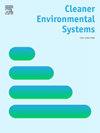Multidimensional assessment of fisheries sustainability in India's largest estuarine system
IF 4.9
Q2 ENGINEERING, ENVIRONMENTAL
引用次数: 0
Abstract
The Hooghly-Matlah Estuarine System (HMES) supports rich fisheries and millions of livelihoods, but overfishing and habitat loss are driving stock declines. Ensuring sustainable fisheries is essential to protect the ecosystem and dependent communities. This study explores how sustainable HMES fisheries truly are, using a modified Rapid Appraisal for Fisheries (RAPFISH) approach. We based our assessment on the hypothesis that current fishing practices may be less sustainable, largely due to challenges across five dimensions—ecology, economy, social, technology, and governance. Multi-dimensional scaling was used to score 45 attributes, followed by leverage analysis to identify key drivers. Data were collected from 38 fishing sites across four zones (8029 km2), including 238 fisher interviews, focus group discussions (4), key informants, and secondary sources. Species- and zone-specific RAPFISH results showed sea catfish fisheries as the most sustainable (57.01 %) and tiger prawn seed fisheries as the least (34.34 %). None of the 22 fisheries were in ‘good’ (75.1–100 %) or ‘poor’ (0–25 %) categories, suggesting room for improvement. Marine zone II (MZII) was “quite sustainable” (53.83 %), while marine zone I (MZI), true estuary (TE), and freshwater (FW) zones were “less sustainable” (25.1–50 %), largely due to lower scores in social, governance, technology, and ecology. Overall RAPFISH scores for HMES were 47.06 % (species-based) and 46.7 % (zone-based), indicating a “less sustainable” status. Although economic and governance dimensions showed moderate strength, zone-specific actions—such as conflict resolution (TE, MZI); enhancing vessel registration and fishing bans (FW, TE); and consolidating governance in MZII, etc., can build resilience and support sustainable estuarine fisheries.
印度最大河口系统渔业可持续性的多维评估
胡格利-马特拉河口系统(HMES)支撑着丰富的渔业资源和数百万人的生计,但过度捕捞和栖息地丧失正在导致种群数量下降。确保可持续渔业对保护生态系统和依赖渔业的社区至关重要。本研究利用一种改进的渔业快速评估(RAPFISH)方法,探讨了HMES渔业的真正可持续性。我们的评估基于这样一个假设,即当前的捕捞方式可能不太可持续,这主要是由于生态、经济、社会、技术和治理这五个维度的挑战。使用多维尺度对45个属性进行评分,然后进行杠杆分析以确定关键驱动因素。数据来自4个区域(8029平方公里)的38个渔场,包括238名渔民访谈、焦点小组讨论(4)、关键线人和二手来源。RAPFISH结果显示,海鲶渔业的可持续性最高(57.01%),虎对虾种子渔业的可持续性最低(34.34%)。22个渔场中没有一个处于“良好”(75.1 - 100%)或“差”(0 - 25%)类别,这表明还有改进的空间。海洋II区(MZII)“相当可持续”(53.83%),而海洋I区(MZI)、真河口(TE)和淡水(FW)区“较不可持续”(25.1 - 50%),主要是由于社会、治理、技术和生态得分较低。HMES的总体RAPFISH得分为47.06%(基于物种)和46.7%(基于区域),表明“不太可持续”的状态。虽然经济和治理维度表现出中等强度,但区域特定行动,如冲突解决(TE, MZI);加强船只登记及禁渔令(FW, TE);加强MZII的治理等,可以建立复原力并支持可持续的河口渔业。
本文章由计算机程序翻译,如有差异,请以英文原文为准。
求助全文
约1分钟内获得全文
求助全文
来源期刊

Cleaner Environmental Systems
Environmental Science-Environmental Science (miscellaneous)
CiteScore
7.80
自引率
0.00%
发文量
32
审稿时长
52 days
 求助内容:
求助内容: 应助结果提醒方式:
应助结果提醒方式:


